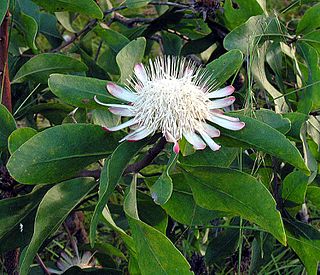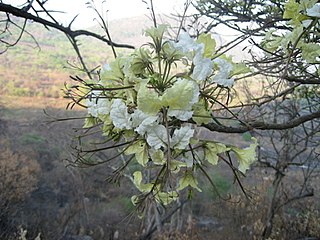
Gymnosphaera capensis, synonyms Alsophila capensis and Cyathea capensis, is a regionally widespread and highly variable species of tree fern. It is indigenous to Southern Africa and South America.

Protea angolensis is also known as the Angolan protea, northern protea or northern sugarbush. In Afrikaans it is known as the noordelijke suikerbos. This is a dwarf, multistemmed shrub or small straggling tree occurring in open wooded grassland and miombo.

Protea gaguedi is a species of tree which belongs to the genus Protea.

Protea welwitschii is a species of shrub or small tree which belongs to the genus Protea, and which occurs in bushveld and different types of grassland.

Senecio barbertonicus, the Barberton groundsel or succulent bush senecio, is an evergreen succulent shrub of the family Asteraceae and genus Senecio, native to Southern Africa, named after one of its native localities Barberton and is now also being cultivated elsewhere for its drought resistance, clusters of sweetly scented, golden-yellow, tufted flower heads in winter and attractiveness to butterflies, the painted lady butterfly in particular.

Deinbollia oblongifolia is a shrub or small tree in the family Sapindaceae. It is commonly known as the dune soap-berry and is found in coastal vegetation from the Eastern Cape of South Africa, through KwaZulu-Natal to southern Mozambique and Eswatini. It is named after Peter Vogelius Deinboll (1783–1876), a Danish botanist and plant collector.

Southern African Sand Forest is a sand forest, or a subtropical forest plant community of the tropical and subtropical dry broadleaf forests biome. It grows on ancient sand dunes in northern KwaZulu-Natal and southern Mozambique. In South Africa these forests are known simply as Sand Forest, while in Mozambique they are known as Licuati Forest. The Southern African sand forest is part of the Maputaland coastal forest mosaic ecoregion.

Capparis fascicularis, the zigzag caper-bush, is a plant in the Capparaceae family and is native to Africa.

Tragia durbanensis, the stinging nettle creeper, is a twining herb in the family Euphorbiaceae, with a restricted distribution in southern Africa. There are some 150 species in the genus Tragia.

Crateva kirkii, commonly known as the three-finger bush, is a small deciduous tree belonging to the Capparaceae or caper family. It ranges through eastern and southern Africa, including Kenya, Tanzania, Democratic Republic of the Congo, Malawi, Mozambique, Zambia, Zimbabwe, Eswatini, and KwaZulu-Natal province of South Africa.

Newtonia hildebrandtii, the Lebombo wattle, is a medium-sized tree native to eastern Africa. It is a protected tree in South Africa.

Dalbergia armata is a scrambling, deciduous species of legume that is native to subtropical to temperate regions of southeastern Africa. The robust, woody liana or small tree is armed with strong spines on the main stem and branches. It occurs sparsely or commonly in forest, bush, riparian fringes and in wooded ravines. It is sometimes employed as a bonsai subject, and it can be propagated from either seed or cuttings.

Boscia foetida, commonly known as the stink shepherd's tree and the smelly shepherd's bush, is an evergreen shrub or tree that is native to the warmer and drier parts southern Africa. It is found in semi-desert and arid bushveld, and in the west it occurs commonly in areas which are otherwise sparsely wooded. It is known for the particularly unpleasant smell of its flowers which appear during early spring, to which its specific name foetida alludes. Its freshly cut wood likewise has an unpleasant smell, and has traditional medicinal and magical uses, for instance as a protection against lightning. In central Botswana the village of Mopipi is named after this species.

Felicia mossamedensis or yellow felicia is a well-branched, roughly hairy, annual or perennial plant of up to 30 cm (1 ft) high, assigned to the family Asteraceae. It has alternately arranged, seated, flat to slightly succulent, broad-based, entire, blunt tipped leaves. The flower heads sit individually on top of a stalk of up to 8 cm (3 in) long, have an involucre of three whorls of bracts, many yellow ray florets and many yellow disk florets. It can be found in southern Africa, in Zimbabwe, Mozambique, Botswana, Eswatini, South Africa and on the coast of Angola.

Cola greenwayi, commonly known as hairy cola or Zulu coshwood, is a species of flowering plant in the family Malvaceae. It was first described in 1956 by the British botanist John Patrick Micklethwait Brenan. It is native to southeastern Africa.

Microcoelia exilis, commonly known as the pinhead orchid, is a species of flowering plant in the orchid family, Orchidaceae. It is a leafless epiphyte, a perennial herb that grows in a tangled cluster of roots and stems on the branch of a tree. This orchid is native to tropical central and eastern Africa and was first described in 1830 by the English botanist John Lindley.
Drypetes gerrardii is a species of small tree or large shrub in the family Putranjivaceae. Common names include forest ironplum, bastard white ironwood, and forest ironwood. It is native to tropical and subtropical central and eastern Africa. It was first described in 1920 by the English botanist John Hutchinson, who named it after the English botanist William Tyrer Gerrard who collected plants and seeds in southern Africa in the 1860s.

Protea dracomontana, the Nyanga protea or the Drakensberg sugarbush, is a flowering plant that belongs within the genus Protea. The plant is found in the Eastern Cape, Lesotho, KwaZulu-Natal and the escarpment of the Free State, as well as eastern Zimbabwe. In Zimbabwe this species is only known from a disjunct subpopulation confined to the summit of Mount Nyangani.

Coffea racemosa, also known as racemosa coffee and Inhambane coffee, is a species of flowering plant in the family Rubiaceae. It has naturally low levels of caffeine, less than half of that found in Coffea arabica, and a quarter of that in Robusta coffee.

Mundulea sericea, the cork bush, is an attractive shrub or small tree which is found in relatively open woodlands of Africa and South Asia. It is the only member of the genus with a range extending beyond Madagascar, and it resembles some African shrubs in the related genus Tephrosia.



















